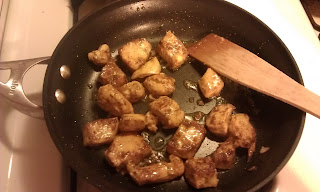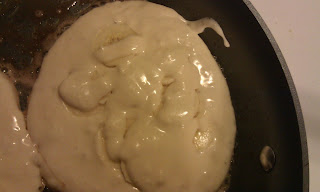My last harvest before that crazy mid-October snow storm!
Making basil pesto is one of the easiest things to do in the kitchen, and frankly one of the most versatile ingredients you can have on hand. We use pesto not only to make pasta, but also to make bread, salad dressings, marinades, and all sorts of sauces.
 -A food processor. You can probably use a blender, too, but this gal here is my favorite wedding present, and I use her often.- Basil of course. Don't use the stems--especially the big ones. Pick off the leaves, wash and dry them before using. I make as big a batch as I can manage. It's just as much work to make a huge batch as it is to make a little one.
-A food processor. You can probably use a blender, too, but this gal here is my favorite wedding present, and I use her often.- Basil of course. Don't use the stems--especially the big ones. Pick off the leaves, wash and dry them before using. I make as big a batch as I can manage. It's just as much work to make a huge batch as it is to make a little one.
-Olive oil.
-Salt
-Pepper
-Nuts. For tradition's sake, use pine nuts. If you're broke or run out, I like walnuts. My grandmother uses peanuts...
How you'll do it:
-Put as much basil as you can muster into the food processor. Add a bit of olive oil (maybe a 1/4 cup to start), salt and pepper.
-Whir that until it breaks down and then cram some more basil in. Add more oil. You may need to add a bit of oil as you whir it, too, to get things going. You'll just have to eyeball it.
-Once you get all of your basil chopped up to an almost paste (aka pesto), add the nuts. I usually do a 1/2 a full cup of nuts depending on what kind of nuts (I use less pine nuts than walnuts). Pulse once or twice to chop them up, but be careful not to make them completely disappear. You want little bits of crunchy in there.
-Salt and pepper to taste.
How to store it:
-I use canning jars or old jelly jars. It seems to be the easiest way for us.
-Once I fill the jars up to about an inch from the brim, I clean the rim, and then top it off with oil before sealing up.
-To keep the pesto green in the jar after using some, make sure that there is always a layer of oil on top of the pesto. This keeps the air out and prevents the oxidation that will turn your pesto brownish.
As mentioned above, I keep them both in the fridge and freezer. There is always one jar of pesto in my fridge ready to go, and the rest hang out in the deep freeze until I need them. To defrost in a hurry, I'll either run the jar under hot water or remove the metal top and put it in the microwave for a minute.
Enjoy!
Making basil pesto is one of the easiest things to do in the kitchen, and frankly one of the most versatile ingredients you can have on hand. We use pesto not only to make pasta, but also to make bread, salad dressings, marinades, and all sorts of sauces.
To store, you can either "oil cure" it as I've shown below (lasts about 2 months in the fridge) or you can freeze it. Our stash never lasts longer than 6 months, but that's because we eat it all the time!
What you'll need:
 -A food processor. You can probably use a blender, too, but this gal here is my favorite wedding present, and I use her often.
-A food processor. You can probably use a blender, too, but this gal here is my favorite wedding present, and I use her often.-Olive oil.
-Salt
-Pepper
-Nuts. For tradition's sake, use pine nuts. If you're broke or run out, I like walnuts. My grandmother uses peanuts...
How you'll do it:
-Put as much basil as you can muster into the food processor. Add a bit of olive oil (maybe a 1/4 cup to start), salt and pepper.
-Whir that until it breaks down and then cram some more basil in. Add more oil. You may need to add a bit of oil as you whir it, too, to get things going. You'll just have to eyeball it.
-Once you get all of your basil chopped up to an almost paste (aka pesto), add the nuts. I usually do a 1/2 a full cup of nuts depending on what kind of nuts (I use less pine nuts than walnuts). Pulse once or twice to chop them up, but be careful not to make them completely disappear. You want little bits of crunchy in there.
-Salt and pepper to taste.
How to store it:
-I use canning jars or old jelly jars. It seems to be the easiest way for us.
-Once I fill the jars up to about an inch from the brim, I clean the rim, and then top it off with oil before sealing up.
-To keep the pesto green in the jar after using some, make sure that there is always a layer of oil on top of the pesto. This keeps the air out and prevents the oxidation that will turn your pesto brownish.
As mentioned above, I keep them both in the fridge and freezer. There is always one jar of pesto in my fridge ready to go, and the rest hang out in the deep freeze until I need them. To defrost in a hurry, I'll either run the jar under hot water or remove the metal top and put it in the microwave for a minute.
Enjoy!



















































